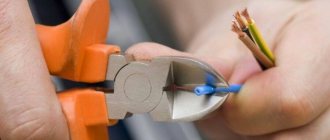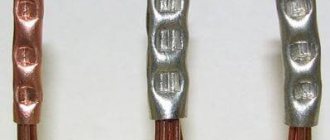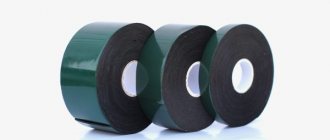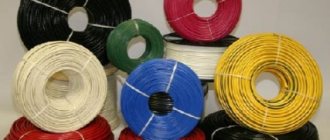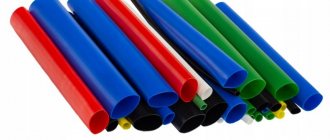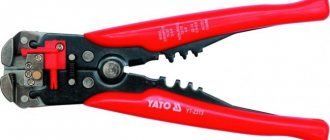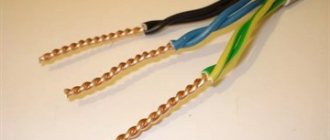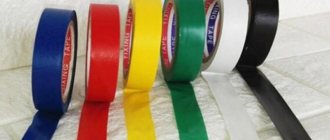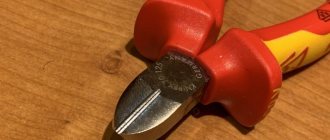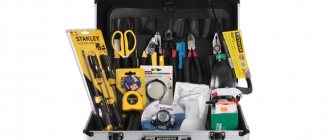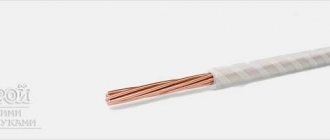SHARE ON SOCIAL NETWORKS
FacebookTwitterOkGoogle+PinterestVk
To perform any work with electrical wires, you cannot do without a special tool designed to remove the braid from them. Such devices should be available not only to a professional electrician, but also to a home handyman who can start repairs in the house. This article will discuss how to choose the right tool for stripping wires, what types of devices exist, where they are used, and many others.
Not only a professional electrician, but also a home craftsman should have a tool for stripping wires.
Why do you need a wire stripper?
To connect a switch or socket in an apartment, it is not necessary to use a professional tool. Here you can use improvised devices that are in the arsenal of any home craftsman. However, it is unlikely that it will be possible to efficiently cope with stripping wires of insulation, especially when it comes to large-scale electrical work.
Without an insulation stripping tool, it is unlikely that you will be able to properly strip the wires.
Poor quality stripping of wire insulation can lead to negative consequences. When using a regular kitchen knife, the likelihood of damaging the cable increases, resulting in a decrease in the level of safe operation of electrical wiring. If a conductor is cut, the cross-section of the wire will decrease, which can cause a break or burn at the connection point. An inaccurate cut often causes the cable to break when it is bent.
When operating high-frequency systems with alternating current, a skin effect may occur, which contributes to uneven distribution of current in the upper layer of the conductor. Any, even the most minor damage to the core will lead to failure of all equipment.
When performing large-scale electrical work, failure to use a special tool to strip wires of insulation can cause a fire, equipment failure, or cause electric shock.
Types of stripping tools
A tool for stripping cable insulation can be classified depending on the method of its removal, the scope of work and the automation of the process. Based on the scope of work, household and professional devices are distinguished. The first group includes an electrician's knife. Professional equipment includes tongs, pliers, strippers and pullers.
Tongs, pliers, strippers and pullers are professional devices for working with electrical wiring.
Important! A tool for electrical work can be universal or for a specific purpose, which is determined by the diameter of the wire being stripped.
The insulating shell can be removed mechanically and thermally. The latter option is used for low-power thin conductors, which are used in communication devices, electronics and audio equipment operating on a voltage of 5 V. Thermal effects can be used for one-time stripping of a small number of conductors. To heat the insulating shell, you should use a soldering iron, lighter or heated chrome thread.
Important! If liquid insulation was used for wires, it can only be removed mechanically.
Professional methods involve removing insulation mechanically. The process may be based on cutting or tearing the shell. In the first case, the insulating layer is cut in a circle using a tip, after which the current-carrying conductors remain undamaged. Part of the cut covering is removed from the wire. The breaking method involves clamping the insulation and tearing it (under force) from the conductor.
Depending on the diameter of the wire to be stripped, the insulation stripping tool can be universal or narrow-purpose
Advantages of a heel stripping knife
A stripping knife with a heel has significant advantages compared to other electrician tools:
- Low probability of damage to current-carrying conductors. The smooth heel glides easily through deeper layers of wire without scratching them while the main blade cuts through the insulation.
- Possibility of using a knife without the involvement of a professional or by a novice specialist. It is difficult to make a mistake when working with a tool with a heel, but it is easy to adapt to removing protection from a wire with it.
- Safety. It is more difficult to injure yourself with a knife with a heel than with a weapon with a “beak” or a hook.
- Possibility of stripping different types of wires. There are tools with a large heel, others have a smaller one, so knives of this type are suitable for working with all cable diameters.
Characteristics of a traditional device in the form of a cable knife
To strip insulation from wires, electricians often use a cable cutter with a rubberized handle and an unusual blade shape. Work must be performed with gloves to eliminate the possibility of injury. This recommendation is especially important when stripping cables made in accordance with GOST, in which the thickness of the insulating coating exceeds that of wires manufactured in accordance with specifications. In addition, it fits much more tightly to the veins.
Important! When stripping a wire, the knife should be held at an acute angle relative to the conductor, which will eliminate the possibility of damaging the cable made of soft material.
The braid is removed with a slight movement, cutting it away from you. The advantages of the knife include the affordable cost of the tool, practicality and ease of use. However, the process of completing the work requires quite a lot of time. This especially applies to large cross-section cables.
Electrical installation knives come in three types, with the tools differing in tip type and blade shape. For cable products with double insulation, a knife with a heel is ideal, with which the top layer is removed, while the bottom remains intact. It is represented by a device in which a short wedge is concave inward. To limit the depth of the cut, the heel is located perpendicular to the blade.
The advantages of a cable cutter are its price, as well as practicality and ease of use.
To make a circular cut in the insulation, use a beaked knife with a rounded blade. The longitudinal cut must be made very carefully, since this device does not have a cut depth limiter. This type of knife is usually used by experienced craftsmen, since working with a tool with a specific wedge shape requires certain skills.
For cross-cutting and longitudinal cutting of cables, a knife with a hook is used, which is considered a universal device for most types of conductors used by professional electricians. The wire is fixed using the upper bracket, and a sharp fang cuts through the insulation. On the device, you can set the depth of the cut using the adjustment wheel. In the case of using liquid insulation for wires (spray, paste), this type of knife is the most suitable for removing the braid.
From A to Z". How to choose an electrician's knife (with a heel). The most detailed review.
Hi all. My name is Anatoly, welcome to my blog. I am the creator of the YouTube channel “Tool Box” https://www.youtube.com/user/YarServisStroy. Today we will talk about knives, but not about simple ones, but about “electrician’s knives” or those with a “heel”. Once upon a time, I also chose a similar knife for myself and came across a great variety of models. Some were different, some were similar and differed only in color. I read a bunch of forums where they mostly praised Knipex, and the competitor was either Chinese or KVT... In general, I bought myself Knipex. But doubts overwhelmed me, I kept thinking, maybe I could have gotten it cheaper???!!! And not to overpay?.. Then I was just starting to shoot videos, so I decided, why not compare them. This is how my first project on the channel called “Electrician’s Knife (with heel)” was born.
Then there were a lot of plans and we decided to buy all the types that were available. So on our channel there were such knives as Haupa, Sata, a knife from Aliexpress, KVT, Knipex, Jokari, NWS. And also a little later we bought TDM and a new KVT and Shtok. Now, in order.
- KNIPEX 9855
I bought it first, long before the project. What can I say about him? I liked it. Initially, it seemed to me that it had a weak sharpening, since many said that they cut easily with it. I tried to compare it with a regular office knife, but over time I realized that this was not correct, since the thickness of the knipex blade is many times greater than that of a segmented one. The heel is small, teardrop-shaped. Has a small angle relative to the handle. Removes insulation quite well. The cut is clean. I would like to say right away that this type of knives is intended mainly for stripping insulation from flat cables. But we, as experimenters, tried to shoot from everything. In general, if you take “TU”, it easily removes insulation from all flat and round ones. If it is “GOST”, then removing the insulation from a flat surface is difficult, on the verge, you have to put in quite a lot of effort. Everything is clearly shown in the videos, links to which I will attach at the end of the article. Well, for those who were interested. Removes insulation from UTP, NYM, PVA, SHVVP, etc. It's hard to say what he's not filming. But again, it’s more convenient to shoot from what it’s intended for, which is flat.
- HAUPA, SHTOK, KVT, Licota, Neo, etc.
HAUPA 20 00 07. This was the first and unsuccessful series, since the knife arrived with a scythe and an obscenely welded heel.
They changed the knife for us. But the quality remains the same. And honestly, if it weren’t for the YouTube channel, I probably would have taken the money. The first thing I want to say is that a huge bunch of knives are produced in this form factor. Our project will include Haupa and KVT. But there are also similar ones from STOK (we’ll look at the new version below), NEO, Licota, etc. They look the same, the difference is often in the name and color.
Now about the knife. I really liked the handle. Comfortable and fits well in the hand. It is two-component, red plastic, black or yellow rubberized part. The blade is about 5 cm long and has a sickle shape, with a metal heel at the end. What I didn't like. The heel is very large and flat compared to the Knipex. And there is no angle, it is welded parallel to the handle. The sharpening turned out to be good. But the above-mentioned shortcomings on the “heel” did their job. It is convenient to remove the insulation only from the “TU” cable, where it is heat-shrinkable, and accordingly there is an opportunity to put this “heel” somewhere. In GOST, the insulation is dense, and there is practically no distance between the cores and the external insulation; accordingly, there are fewer options for inserting this “heel”. Plus, the thickness of the heel is practically equal to the VVGng 2x1.5 cable, it is very difficult to remove the insulation from it. As for Haupa, we didn’t have this knife until the end of the project. At first we changed it because of the crooked heel. Then it got even worse. During the process of removing the insulation, my heel was broken. And it would be okay just once. They sent us a new one to replace the broken one, but it also did not pass the tests. Regarding KW. He reached the end, but this does not mean at all that he is better than the haupa. Here, in my opinion, it’s a matter of chance. The heel could fall off on everything, since these knives are made at the same factory. On the plus side. In one of the series, we re-sharpened the KVT, made the heel much smaller, and used Knipex as a sample. Looking ahead, the same procedure was later carried out by the plant, but more on that later.
- N.W.S. WEICON
NWS VDE 2043K. What is its feature? Firstly. This is not the first variation of this knife; if now it is yellow and red in a combination of plastic and rubber, then before it was just plastic.
Now Weicon is produced in the same variation with a different color, but still the same form factor. Well, you yourself understand that there are many companies, or rather brands, but there is only one knife for everyone.
Now for more details. I liked this knife tactilely. Doesn't feel bad in the hand. Recesses for fingers are appropriate. But if you compare it with the above samples, the grip is not so comfortable. Since here the cut of the handle goes perpendicular to the blade. And on the above ones at an angle. The heel is small and has an angle relative to the handle. There is only one minus. The sharpening failed. It's very difficult to start cutting. What's forward, what's back. After using this knife I realized that Knipex is sharp. Because of this sharpening, it is inconvenient to remove the insulation. As practice has shown, this happens. And this is more a defect than a pattern. Therefore, I advise you to check the knife when purchasing so as not to end up in such situations... And this applies to any brand.
Knife from AliExpress I had no luck with it either. Yes, it was the cheapest knife we bought. Its shape was copied from Knipex. Previously, it was produced in the same form factor by KVT and SHTOK.
What would you like to say about him? If you manage to get a sharpened copy, you won’t regret it, but if it arrives as stupid as ours, then it’s a waste of money. The shape is clear from the picture. The front part is the same as on the knipex. The handle is different. completely plastic. Again, it was originally copied from Knipex. We made two issues about this knife. Links to them will be below.
- SATA. TDM Electric etc.
We ordered Sata from Aliexpress. At first it seemed that it was similar to KVT, haupa, etc., but in reality it turned out to be different. We later purchased a similar knife under the TDM brand.
The most interesting. They turned out to be the same. That one doesn't work, the other doesn't work. If we had no choice with sata. They couldn't touch him. Things were better with TDM. The picture shows that we chose from everything that was in the store, but this abundance did not help. Either in China or in the store, there was only one problem, the distance between the heel and the blade. And there is only one reason, poor and low-quality welding. The knife cannot cut forward or backward. Yes, that's a good idea. It's really small and compact, but the execution lets us down. It let me down so much that I don’t even have words. You can also watch the videos in more detail.
- Jokari, Cimco, NWS, etc.
Jokari VDE Cable Stripper.
This is the most expensive knife we purchased for the project. It cost us about 4 thousand, with the price of a knipex being 2.5... Completely plastic, no rubberized parts. The heel is reminiscent of the aforementioned NWS, it feels like the upper is an upgraded version of that. From jokes. I ordered yellow, but it arrived red. There are no inscriptions. By removing insulation. It takes good pictures, on par with knipex. But the price is not affordable.
- New from KVT and STOK.
These knives came out recently. Essentially they represent a new version of the previous ones. They left all the best, and this is the hand. And they replaced the bad one. And then the blade. We made the heel smaller and gave it an angle relative to the handle. We made protection on the top of the blade. Well, they reduced the cap.
In our review we compared this knife with a Knipex. They compared not only externally, but also in terms of cable cutting. You can write a lot of things here, but, in my opinion, it’s better to see. Knipex or KVT? What's better to see? Knipex or KVT? What's better? New. KVT NMI-01(A) and KNIPEX KN 9855. Electrician's knife (with heel) #13.
That's all. Now the promised links to the project “Electrician’s Knife (with heel)” For those who are impatient. Final release. Comparison of Knipex, Haupa, Jokari, NWS, KVT, Sata and Stock. Final test. Electrician's knife (with heel) #10.
Well, a link to the playlist, where you can find a review of each knife individually. https://www.youtube.com/playlist?list=PLd8AHVweS4s8WYuV3a1xRuZNpJt5UdJ_v
Enjoy watching.
If you have any questions, I will be happy to answer them in the comments.
Pliers, wire cutters, side cutters and pliers for stripping insulation
To break the insulating layer on the conductor, pliers or wire cutters are used. The principle of operation of the device is quite simple. Using the adjusting screw, the required wire diameter is selected. The clamps secure the cable. With a circular scrolling motion, the insulation is pulled up and torn off the conductor.
Important! The grip width should be slightly larger than the cross-section of the conductor, which will protect the cable and wires from scratches when removing the protective layer.
Pliers and side cutters are tools that can also be used to remove insulation
Wire strippers are made primarily of high quality steel with insulated handles. There are models that are capable of stripping the thinnest wires without breaking. The advantages of such a tool include reliability, durability, the ability to carry out work in hard-to-reach areas, and stripping live conductors.
Disadvantages include the need to constantly adjust the screw to strip wires of different cross-sections and the inability to select the length of removal of the insulation layer.
Important! Wire cutters allow you to remove the insulating coating from a conductor as accurately and quickly as possible.
Alternative options that can also be used to strip wires are pliers and side cutters. The latter option is used for cutting the insulation of small diameter wires. When working with this tool, it is important to control the pressure force to eliminate the possibility of damage to the wire.
To tear the insulating layer on the wire, pliers or wire cutters are used.
For processing conductors, universal tools in the form of pliers, in which rubberized holes have different diameters, are also in demand. The functionality of the pliers depends on the number of holes. Typically the tool is designed for 3-6 wire sizes. The section parameter is indicated on the handle. The standard range is 0.5-3 mm². Using this device, you can grip and bend wires, cut medium-hard conductors, crimp contact sleeves, and remove insulation.
Varieties of design
Structurally, knives for stripping electrical wires can be folding or non-folding, with a straight or curved blade. In any case, the blade should be moderately sharp, there should be no burrs or notches on it, otherwise when stripping the cable, the wires can easily be damaged.
If a folding knife is used for electrical work, it must be equipped with a reliable lock so that when stripping the cable the blade does not fold spontaneously. The blade must be sharpened on both sides. It is desirable that the cutting edge has an internal rounding - this simplifies the removal of insulation from the wire.
As already mentioned, an electrician does not need too sharp a tool, since it is easy for them to cut fingers and also damage metal conductors. An overly sharpened blade can cause accidental damage to the insulation of the wrong wire that is being processed.
It is very important to strip the wire correctly. Many people cut the insulation around the circumference and then pull it off the core, but this often leads to damage to the metal part of the cable.
The insulating material should be cut using movements similar to those made when sharpening a pencil.
Distinctive features of insulation strippers
The most popular and in demand device for stripping wires is a stripper. This is a specialized tool that performs cable processing using two movable knives that have a semicircular shape. Based on the size of the wire cross-section, the required caliber of the tool is selected, which guarantees an accurate notch and no damage to the wire.
The stripper can be mechanical, semi-automatic or automatic. The first option is represented by a hand-held device that has a simple design and resembles pliers in appearance. A manual cable cutter is used to strip individual wires. Due to the presence of several holes of different diameters with blades on the inner surface of the clamps, it is possible to process cables of different sections, ranging from 0.25-2.5 mm.
Important! The cost of a mechanical stripper directly depends on the number of sockets on the lips of the instrument and their digital value.
The most popular tool for stripping wires is a mechanical stripper.
This type of stripper has compact dimensions and light weight, which makes it convenient and practical to use. To remove the insulation, the size of the hole is selected, the cable is bitten, and when performing circular movements, the insulation is torn off the wire. The cost of such a stripper for stripping wires is on average 400-1000 rubles.
Semi-automatic and automatic wire stripper
To perform large volumes of work, it is recommended to use a semi-automatic version, equipped with a special mechanism that does not require turning the stripper around the wire. With its help, you can remove insulation from several cores at once. To remove the protective layer, select the required recess corresponding to the cross-sectional diameter of the wire, place the conductors in it and remove the insulation by applying pressure to the handle. You can buy such a stripper for 1200-2500 rubles.
Important! The semi-automatic stripper is equipped with a limiter, due to which the insulation will not be removed beyond the selected limit.
An automatic tool for stripping wires and removing insulation simplifies the work as much as possible. To remove insulation, it is not necessary to select the diameter of the cable cross-section. The device has one socket, the size of which adjusts automatically to the installed cable. The tool can be used for wires with a cross section of 0.2-6 mm.
Strippers are mechanical, semi-automatic and automatic
Automatic strippers have expanded functionality, which involves crimping lugs, cutting cable ends, and twisting stranded wires. The device can be used for stripping wires with single and double insulation. One manipulation allows you to remove one layer. To remove the second braid, the procedure is repeated.
Some manufacturers produce a special type of wire stripping pliers that are used for processing twisted pair cables. The tool is made in the form of a clamp equipped with a built-in blade. Such a device can perform a manipulation that facilitates accurate and accurate removal of the outer sheath of the cable. This tool allows you to process coaxial cables for subsequent installation of the F-connector.
For optical fibers and power cables, there is a special type of semi-automatic wire stripping machine, which ensures high precision in stripping the insulating coating. Such a tool has a fairly high cost and is used by professionals to carry out highly specialized tasks.
Important! This type of stripper allows you to remove the thinnest layers of insulation from a fiber optic cable.
Special types of pliers are used to process twisted pair cables.
How to make a knife with a heel yourself?
As we have seen, a repair knife equipped with a heel is a very convenient tool that has serious advantages. However, it has one serious drawback - the high cost, due to which many people cannot afford such a purchase.
If you have to do electrical work only periodically, as is usually the case in the household, purchasing a specialized tool is not practical.
However, you can make such an electrician’s knife with your own hands; this procedure does not present any difficulties. Let's take a closer look at how to do it and what we need for this.
Materials for work
To make a homemade knife with a heel for stripping wires, you first need to stock up on the accessories that are listed below:
- Blades for a stationery knife (2 pcs.)
- Aluminum profile from which the handle will be made. A piece of metal base from a mosquito net used in PVC windows is quite suitable.
- The rail is made of wood, which should be somewhat inferior to the profile in its cross-section.
- Soldering iron with POS solder and phosphoric acid.
- Diamond cutting microdisc.
- Bormashinka.
Having prepared all the necessary materials and tools, you can proceed directly to assembling the knife with the heel.
Manufacturing procedure
A homemade repair knife is made in the following order:
- Cut a spike on a stationery blade to which the heel will be attached.
- Grind off the excess sharpening so that only the edge remains sharpened.
- Sharpen the opposite side of the blade.
- Make a heel with a slot from a piece of the second blade that will correspond to the thickness of the cutting blade.
- Using a soldering iron and solder, attach the manufactured heel to the first blade. Give its edges an oval shape so that during operation of the tool it cannot damage the insulation of the cores and their metal base.
- Insert the blade into a piece of metal profile and secure it inside using a wooden strip with a cut.
- Drill a hole in the handle so that it is aligned with the one already in the blade.
- Insert a bolt into the hole and secure it with a nut on the other side.
At this point the work is completed, the tool is ready for use.
A slightly different technology for making a knife with a heel in the video:
Stripping options for different types of wires
The complexity of the process of removing the insulating layer from wires is determined by the type of cable. The coaxial wire has a double protective braiding, which is removed in two stages. To remove the top layer, you can use a thermal method, and to eliminate the bottom layer, you should use a stripper. There are pliers of a special design, equipped with an additional blade and replaceable inserts for wires of different sections. This tool allows you to remove both shells.
Important! It must be remembered that the cores of a coaxial cable are quite thin and fragile, so manipulations with stripping the insulation should be carried out with extreme caution.
If silicone insulation is used for wires, only use a cable cutter to remove it. A fluoroplastic-coated wire has a heat-resistant insulating coating that can only be removed mechanically. To do this you will need any cable cutter or stripper.
Related article:
Heat shrink for wires and its use as an insulating material
Classification of products, their characteristics and cost. How to choose and install the handset correctly.
To remove the insulating layer from an enameled wire, you can resort to the thermochemical method using vinyl chloride tape and a soldering iron if the cable cross-section is no more than 0.2 mm². The conductor is placed on the tape, where a hot soldering iron is passed over it. Under the influence of high temperature, chlorine is released, which contributes to the removal of enamel insulation from the wire.
When choosing a tool for removing insulation, you need to know what cross-section of wire the device will be used for.
Helpful advice! To remove the insulating coating from electrical cables, you should choose strippers equipped with a handle made of dielectric material, which can provide protection against voltages up to 1000 V.
When choosing a device for stripping wires, you must consider what cross-section of wire the device can be used for. A cable cutter is a universal element in terms of size, while pliers, pliers, mechanical and semi-automatic strippers have a limited gripping range.
Review of the best models of strippers for stripping wires
The insulation stripping tool from the domestic manufacturer KVT is very popular. The company offers high-quality models of strippers at an affordable price. One of the most popular models is the WS-04A insulation stripping tool, which is designed to remove braiding from wires with a cross-section of 0.05-6 mm². Using the micro-adjustment screw, you can adjust the hole diameter to suit the cable size. You can buy a stripper for 1.2 thousand rubles.
To remove the insulating braid from flat conductors PUNP and VVG-P and to clean the sheath from a cable with a cross-section of 0.05-10 mm², you can use the KBT WS-11 model. The insulation stripping tool has a micro-adjustment screw, which allows you to select the required hole diameter for a specific cable size. For convenient operation, the tool is equipped with two-component handles and reinforced clamping lips with a grip width of 13 mm.
The WS-04A insulation stripping tool from KBT is one of the most popular devices
This stripper model allows you to simultaneously strip several wires in one movement, which is done thanks to the wide clamping lips. The tool is equipped with the option of partial removal of insulation. The cost of the stripper is 1.4 thousand rubles.
Another good domestic model is the KBT WS-12 stripping tool, which is used for multi-core and multi-conductor cables with a cross-section of 0.05-10 mm². The device is equipped with a built-in module for cutting wires. The blades of the tool are made of stainless steel. They have guides that protect against loosening and oblique cutting. The tool can strip the insulation from the middle of the wire. The removable all-metal adjuster allows you to set the distance required to remove the braid. The cost of the tool is 1.5 thousand rubles.
In-demand KBT stripping tool
A compact and easy-to-use insulation stripping tool – KVT KS 25. It is designed for SIP cables with a cross-section of 4.5-25 mm². The stripper has a rotating, length-adjustable blade that removes braiding 3.5 mm thick. Insulation cuts can be made longitudinally, transversely and spirally. The body of the device is made of impact-resistant plastic, which guarantees the reliability and durability of the device.
To manipulate wires, the tool can be placed on a table and secured with a spring-loaded clamp. You can buy a stripper for 1.5 thousand rubles.
The WS-06 tool is an automatic stripper that is adjusted to the required insulation thickness
The KBT WS-06 insulation stripping tool is an automatic stripper that adjusts to the required insulation diameter and thickness. It is designed for stranded wires up to 2 mm in size. Removes braid with a cross section of 0.2-6 mm². The body of the device is made of fiberglass, which makes it durable, reliable and easy to use.
Important! This model has tapered ends, which allows the device to be used in hard-to-reach places.
The tool is equipped with a length limiter for stripping. The handles have a lock in the folded position, which ensures convenience and safety when storing the device. Using this stripper, you can perform V-shaped cutting of cable edges when stripping wires from insulation. The tool can be purchased for 1.3 thousand rubles.
Cable cutting knives
Product catalog » Cable cutting knives
Dear customers! There is a spare blade in the knife body (except JOKARI 10286).
The most popular models: JOKARI 10160; JOKARI 10280;
Jokari 10500 – cable cutting knife Jokari Standard No. 50 Cable cutting knife Jokari Standard No. 50 JK 10500 is used for peeling round...
Price: 3880 rub.
Add to cart
Jokari 10160 – cable cutting knife Secura No. 16 Designed for removing the sheath from round cables with a diameter of 4 to 16 mm. Using a screw...
Price: 1310 rub.
Add to cart
Jokari 10162 – cable cutting knife Standard No. 16 Designed for removing the sheath from round cables with a diameter of 4 to 16 mm. Using a screw...
Price: 1100 rub.
Add to cart
Jokari 10270 – cable cutting knife Secura No. 27 Designed for removing the sheath from round cables with a diameter of 8 to 28 mm. Using a screw...
Price: 1710 rub.
Add to cart
Jokari 10271 – cable cutting knife Standard No. 27IS Designed for stripping round cables with a diameter of 8 to 28 mm. Fully…
Price: 2760 rub.
Add to cart
Jokari 10272 – cable cutting knife Standard No. 27 Designed for removing the sheath from round cables with a diameter of 8 to 28 mm. Using a screw...
Price: 1350 rub.
Add to cart
Jokari 10280 – cable cutting knife Secura No. 28H Designed for removing the sheath from round cables with a diameter of 8 to 28 mm. Additional…
Price: 1410 rub.
Add to cart
Jokari 10281 – cable cutting knife Secura No. 28G Designed for removing the sheath from round cables with a diameter of 8 to 28 mm. Additional…
Price: 1150 rub.
Add to cart
Jokari 10282 – cable cutting knife Standard No. 28H Designed for removing the sheath from round cables with a diameter of 8 to 28 mm. Additional…
Price: 1170 rub.
Add to cart
Jokari 10285 – cable cutting knife Standard No. 28G Designed for removing the sheath from round cables with a diameter of 8 to 28 mm. Additional...
Price: 1410 rub.
Add to cart
Jokari 10286 – cable cutting knife No. 28H Ecoline Special cheaper version. It features a simplified body, no TiN coating on…
Price: 800 rub.
Add to cart
Jokari 10350 – cable cutting knife Standard No. 35 Designed for removing the sheath from round cables with a diameter of 27 to 37 mm. Using a screw...
Price: 3220 rub.
Add to cart
Jokari 10530 - knife for cutting cable VDE Cable Stripper Price: 3800 rub.
Add to cart
Jokari 70000 - cable cutter System 4-70 Price: 3820 rub.
Add to cart
